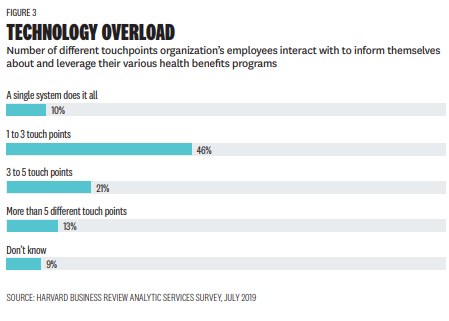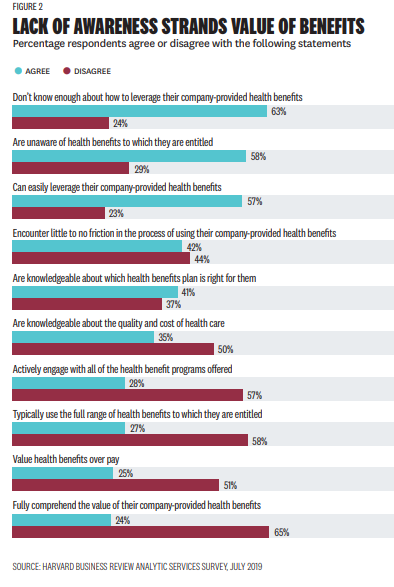
A new survey suggests employers are right to be skeptical about the growing sums of money they devote to healthcare benefits.
Corporate leaders see the benefits as vital to attracting and retaining talented workers, and they show little sign of cutting back. But in a survey released this week, those same leaders acknowledged that employees often are unaware of their companies’ offerings, resulting in low engagement and under-used benefit packages.
Compounding the problem is the array of portals employees may have to navigate to get to their benefits, according to a report accompanying the survey, which was conducted by Harvard Business Review Analytic Services and presented under a partnership with Toronto-based health-benefits tech firm League Inc.
Only 10 percent of those surveyed said their companies have a single access point for employees to tap into health benefits. Nearly half, or 46 percent, have one to three access points, with the remainder having more.

“Moreover, many of the systems’ employees can access are geared more toward insurance providers and are more transactional,” the report said. “In other words, they run counter to being consumer/employee friendly in their design.”
The report suggested technologies such as data analytics and artificial intelligence could play a role in the solution. For example, employees researching one benefit, such as a parental leave policy, could be delivered recommendations – à la Amazon – for related benefits, such as childcare or options for working remotely.
Regardless of how the challenges are addressed, the survey makes clear that employers increasingly see health benefits as a weapon in the war for attracting the best employees. And it is one they have no plans to give up.
The survey results were based on 238 responses gathered in June from the Harvard Business Review audience, including print and online readers. More than two-thirds, or 70 percent, were in senior management, with another 19 percent representing executive management and board members.
Most respondents were from larger companies. About half, or 49 percent, employed more than 5,000 people. One-fifth, or 18 percent, employed between 500 and 999 people. They represented a range of industries, including healthcare (21 percent), financial services (13 percent) and manufacturing (11 percent).
Roughly three-quarters of survey respondents, or 77 percent, consider innovative health benefits as a key factor in a company’s competitiveness. More than half, 51 percent, expect health benefits will become even more important in the future.

At the same time, 63 percent of respondents expressed concern over employees’ ability to leverage their company-provided health benefits, while 58 percent said employees were simply not aware of the health benefits being offered.
Only 28 percent of respondents agreed their employees actively engage with all the health benefits available to them.

“Low awareness, knowledge and engagement often have far-reaching deleterious effects, resulting in higher overall health care costs, poorer employee health, employee absenteeism, and lower productivity,” the report said.
At the same time, employees in search of benefits information may often turn to HR departments due to the fragmented way information is delivered, the report said. The requests can become a drag on an HR department’s time, diverting staff from higher-level activities such as researching innovative benefits.
Multiple access points also may hinder the collection of data that could be used to boost engagement and determine whether benefits are working, the report said.
“There is a profound disparity between what employers are doing to provide health benefits and what employees are actually getting from these efforts,” Mike Serbinis, CEO of League, said in a statement. “To close this gap and improve health outcomes while reducing costs, the entire ecosystem needs to become employee-centric. Employers need to think about how they can streamline the current sea of point solutions and empower employees to proactively manage their health.”















